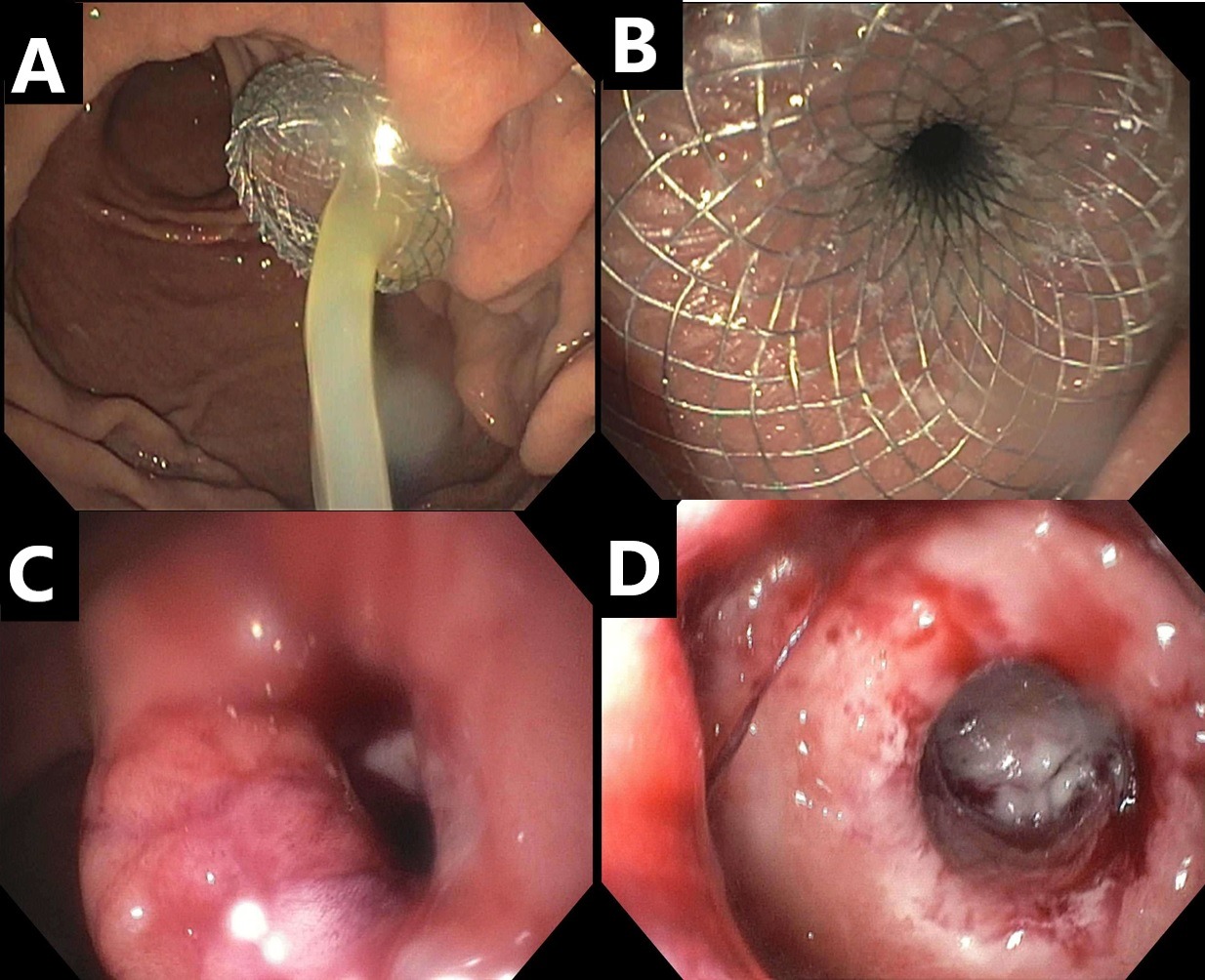Back
Poster Session A - Sunday Afternoon
A0433 - An Unusual Case of AXIOS Stent Migration into the Gastric Body and Retrieval Occurring 4 Weeks Post Placement for Drainage of a Pancreatic Pseudocyst in a 48-Year-Old Male
Sunday, October 23, 2022
5:00 PM – 7:00 PM ET
Location: Crown Ballroom

Ammar Aqeel, MD
MercyHealth Internal Medicine Residency
Rockford, IL
Presenting Author(s)
Ammar Aqeel, MD1, Mudassar K. Sandozi, DO2, Naser Khan, MD3, Altaf Dawood, MD4, Luqman Baloch, MD4, Saagar Pamulapati, MD1
1MercyHealth System, Rockford, IL; 2MercyHealth Internal Medicine Residency, Rockford, IL; 3MercyHealth, Rockford, IL; 4MercyHealth Internal Medicine Residency Program, Rockford, IL
Introduction: Though a patient’s clinical picture dictates management, transendoscopic cystograstomy stenting is emerging as a favored first line therapy for the management of pancreatic pseudocysts. We present a case of AXIOS stent migration that occurred 4 weeks post placement for drainage of a pancreatic pseudocyst.
Case Description/Methods: A 48-year-old male with past medical history of hypertension, duodenal ulcer, and alcohol induced pancreatitis presented to our GI clinic with two-months of persistent epigastric pain. Social history included heavy alcohol and tobacco use. EGD employed for evaluation revealed extrinsic compression of the proximal, horizontal and descending duodenum. Follow-up CT scan of the abdomen and pelvis found a new 9.3 x 9.5 x 10.2 cm cystic lesion occupying the pancreatic head and uncinate process concerning for a pancreatic pseudocyst with extrinsic compression of the distal stomach and descending and transverse duodenum. Mild, diffuse, 5-6 mm pancreatic ductal dilation within the pancreatic body, represented likely extrinsic compression of the pancreatic duct. Follow up EUS and tissue diagnosis confirmed an anechoic lesion suggestive of a pseudocyst in the pancreatic head and body. EGD cystograstomy with a 15 x 10 mm AXIOS stent successfully drained large amounts of yellow fluid. The patient tolerated the procedure well and presented four weeks later for stent removal. Follow up EGD and EUS found the previously placed stent to have migrated with the proximal edge of the stent within the stomach wall. Stent was successfully removed with a Raptor grasping device and the cystograstomy cavity appeared otherwise healthy. Patient’s pseudocyst resolved with no further complications.
Discussion: Management of pancreatic fluid collections can be surgical percutaneous, or transendoscopic depending on the patient’s clinical picture, with endoscopy becoming more widely favored as the first-line treatment. The implementation of lumen-apposing self-expanding stents generally replaced plastic and metallic stents due to their unique shape offering a lesser risk of stent migration. Despite this innovation, rare cases of stent migration still occur. An awareness of the possibility migration allows proceduralist to manage these cases with favorable outcomes, as what occurred in our case.

Disclosures:
Ammar Aqeel, MD1, Mudassar K. Sandozi, DO2, Naser Khan, MD3, Altaf Dawood, MD4, Luqman Baloch, MD4, Saagar Pamulapati, MD1. A0433 - An Unusual Case of AXIOS Stent Migration into the Gastric Body and Retrieval Occurring 4 Weeks Post Placement for Drainage of a Pancreatic Pseudocyst in a 48-Year-Old Male, ACG 2022 Annual Scientific Meeting Abstracts. Charlotte, NC: American College of Gastroenterology.
1MercyHealth System, Rockford, IL; 2MercyHealth Internal Medicine Residency, Rockford, IL; 3MercyHealth, Rockford, IL; 4MercyHealth Internal Medicine Residency Program, Rockford, IL
Introduction: Though a patient’s clinical picture dictates management, transendoscopic cystograstomy stenting is emerging as a favored first line therapy for the management of pancreatic pseudocysts. We present a case of AXIOS stent migration that occurred 4 weeks post placement for drainage of a pancreatic pseudocyst.
Case Description/Methods: A 48-year-old male with past medical history of hypertension, duodenal ulcer, and alcohol induced pancreatitis presented to our GI clinic with two-months of persistent epigastric pain. Social history included heavy alcohol and tobacco use. EGD employed for evaluation revealed extrinsic compression of the proximal, horizontal and descending duodenum. Follow-up CT scan of the abdomen and pelvis found a new 9.3 x 9.5 x 10.2 cm cystic lesion occupying the pancreatic head and uncinate process concerning for a pancreatic pseudocyst with extrinsic compression of the distal stomach and descending and transverse duodenum. Mild, diffuse, 5-6 mm pancreatic ductal dilation within the pancreatic body, represented likely extrinsic compression of the pancreatic duct. Follow up EUS and tissue diagnosis confirmed an anechoic lesion suggestive of a pseudocyst in the pancreatic head and body. EGD cystograstomy with a 15 x 10 mm AXIOS stent successfully drained large amounts of yellow fluid. The patient tolerated the procedure well and presented four weeks later for stent removal. Follow up EGD and EUS found the previously placed stent to have migrated with the proximal edge of the stent within the stomach wall. Stent was successfully removed with a Raptor grasping device and the cystograstomy cavity appeared otherwise healthy. Patient’s pseudocyst resolved with no further complications.
Discussion: Management of pancreatic fluid collections can be surgical percutaneous, or transendoscopic depending on the patient’s clinical picture, with endoscopy becoming more widely favored as the first-line treatment. The implementation of lumen-apposing self-expanding stents generally replaced plastic and metallic stents due to their unique shape offering a lesser risk of stent migration. Despite this innovation, rare cases of stent migration still occur. An awareness of the possibility migration allows proceduralist to manage these cases with favorable outcomes, as what occurred in our case.

Figure: Image A, B – View of successful placement of 15x10-mm AXIOS stent during cystogastrostomy.
Image C – 4 week follow up after placement shows AXIOS stent in the gastric body, migrated inside the gastric wall.
Image D – Cystogastrostomy cavity post removal of migrated stent with Raptor grasping device. Cavity is healthy with some granulation tissue.
Image C – 4 week follow up after placement shows AXIOS stent in the gastric body, migrated inside the gastric wall.
Image D – Cystogastrostomy cavity post removal of migrated stent with Raptor grasping device. Cavity is healthy with some granulation tissue.
Disclosures:
Ammar Aqeel indicated no relevant financial relationships.
Mudassar Sandozi indicated no relevant financial relationships.
Naser Khan indicated no relevant financial relationships.
Altaf Dawood indicated no relevant financial relationships.
Luqman Baloch indicated no relevant financial relationships.
Saagar Pamulapati indicated no relevant financial relationships.
Ammar Aqeel, MD1, Mudassar K. Sandozi, DO2, Naser Khan, MD3, Altaf Dawood, MD4, Luqman Baloch, MD4, Saagar Pamulapati, MD1. A0433 - An Unusual Case of AXIOS Stent Migration into the Gastric Body and Retrieval Occurring 4 Weeks Post Placement for Drainage of a Pancreatic Pseudocyst in a 48-Year-Old Male, ACG 2022 Annual Scientific Meeting Abstracts. Charlotte, NC: American College of Gastroenterology.
